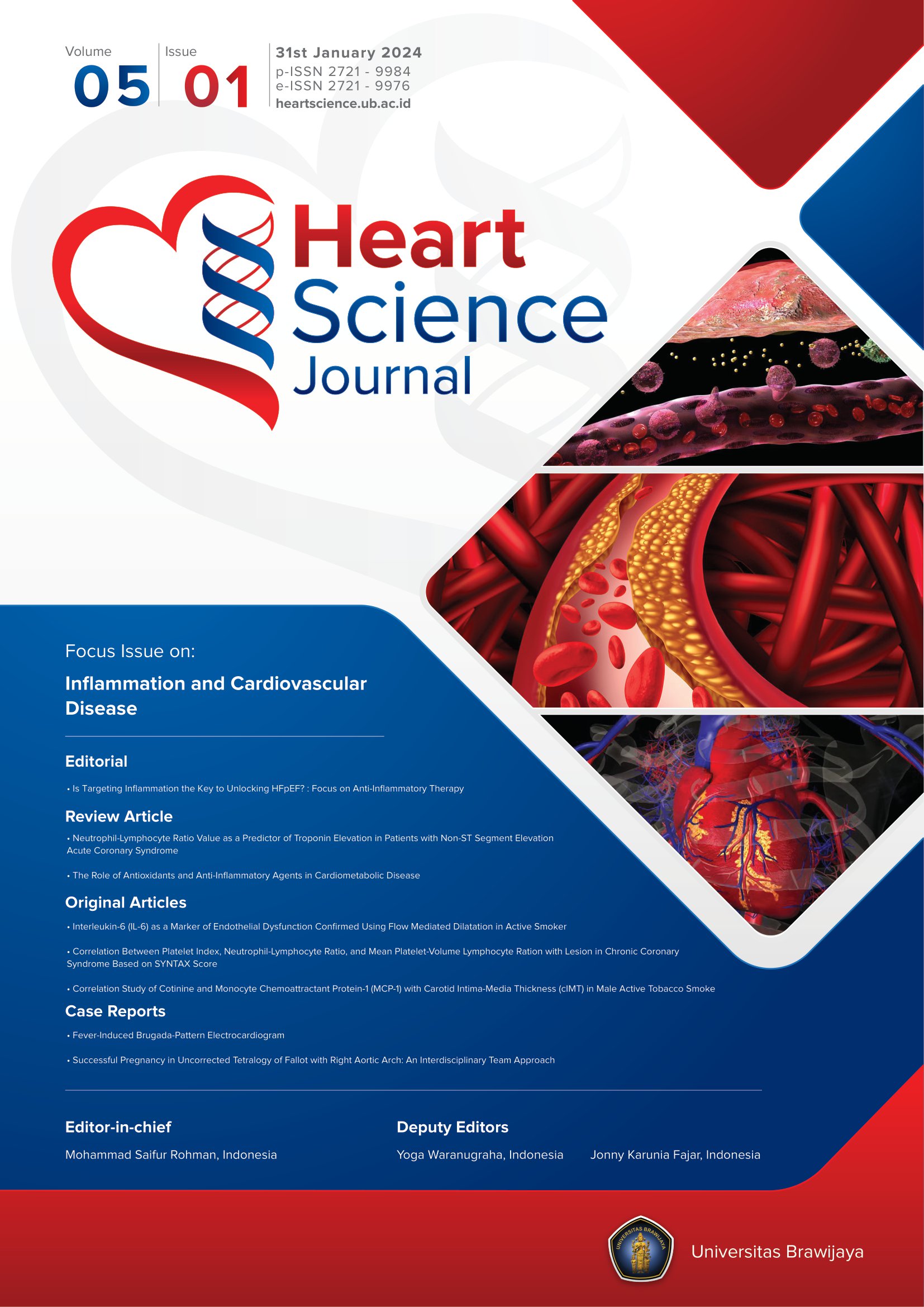The Effect of Bisoprolol on Heart Failure Preserved Ejection Fraction/HFpEF Patient’s Quality of Life
Abstract
Global Publich Health Burden of Heart Failure reported the growing prevalence of heart failure from 26 million people affected in 2017 to 64.3 million affected in 2020 worldwide with half of the case classified as heart failure preserved ejection fraction/HFpEF. It is well known that someone who have been diagnosed with heart failure will have a poorer quality of life/QoL. β-blocker is a heart rate lowering agent with a potency to improve the patient’s clinical outcome. One clinical outcome that should always be evaluated and become the main goal of the therapy is QoL of the patient. This study aimed to observe and evaluate the effect of Bisoprolol, a type of β-blocker, in the improvement of HFpEF patient’s QoL. This study is a retrospective cohort following HFpEF patients who received β-blocker and HFpEF patients who did not received β-blocker in a span of 6 months. The study participant selected by purposive sampling method. Our study found that from all HFpEF patients who received β-blocker 86 patients had a good QoL, 16 patients had a Mod QoL, and 2 patients had a poor QoL (p=0.000). Mean physical score in the patient who did not received β-blocker was 13.84±11.01 while the mean score of the patient who received β-blocker was 5.94±4.95 (p=0.000). Mean emotional score in the patient who did not received β-blocker was 6.02±6.61 while the mean score of patient who received β-blocker was 1.83±2.16 (p=0.000). We conclude that the use of Bisoprolol could improve the HFpEF patient’s QoL evaluated by total score, physical score, and emotional score.
Keywords
Full Text:
PDFReferences
Adamson, P. B. et al. (2014) ‘Wireless pulmonary artery pressure monitoring guides management to reduce decompensation in heart failure with preserved ejection fraction.’, Circulation. Heart failure. United States, 7(6), pp. 935–944. doi: 10.1161/CIRCHEARTFAILURE.113.001229. Ahmad, S. S. and Gerson, M. C. (2018) ‘Sympathetic drive stimulating diastolic dysfunction?’, Journal of nuclear cardiology : official publication of the American Society of Nuclear Cardiology. United States, pp. 1110–1113. doi: 10.1007/s12350-017-0809-z. Alehagen, U. et al. (2015) ‘Association Between Use of Statins and Mortality in Patients With Heart Failure and Ejection Fraction of ≥50.’, Circulation. Heart failure. United States, 8(5), pp. 862–870. doi: 10.1161/CIRCHEARTFAILURE.115.002143.
Andersson, C. and Vasan, R. S. (2014) ‘Epidemiology of heart failure with preserved ejection fraction.’, Heart failure clinics, 10(3), pp. 377–388. doi: 10.1016/j.hfc.2014.04.003.
Antoniades, C. et al. (2011) ‘Rapid, direct effects of statin treatment on arterial redox state and nitric oxide bioavailability in human atherosclerosis via tetrahydrobiopterin-mediated endothelial nitric oxide synthase coupling.’, Circulation, 124(3), pp. 335–345. doi:10.1161/CIRCULATIONAHA.110.985150.
Baxter, A. J. et al. (2002) ‘Beta blockers in older persons with heart failure: tolerability and impact on quality of life.’, Heart (British Cardiac Society), 88(6), pp. 611–614. doi: 10.1136/heart.88.6.611. Beale, A. L. et al. (2018) ‘Sex Differences in Cardiovascular Pathophysiology: Why Women Are Overrepresented in Heart Failure With Preserved 101 Ejection Fraction.’, Circulation. United States, 138(2), pp. 198–205. doi:
1161/CIRCULATIONAHA.118.034271.
Behlouli, H. et al. (2009) ‘Identifying relative cut-off Scores with neural networks for interpretation of the Minnesota Living with Heart Failure questionnaire.’, Annual International Conference of the IEEE Engineering in Medicine and Biology Society. IEEE Engineering in Medicine and Biology Society. Annual International Conference. United States, 2009, pp. 6242–6246. doi:10.1109/IEMBS.2009.5334659.
Blaufarb, I., Pfeifer, T. M. and Frishman, W. H. (1995) ‘Beta-blockers: Drug interactions of clinical significance.’, Drug safety. New Zealand, 13(6), pp. 359–370. doi: 10.2165/00002018-199513060-00005. Böhm, M. et al. (2015) ‘Resting heart rate: risk indicator and emerging risk factor in cardiovascular disease.’, The American journal of medicine. United States, 128(3), pp. 219–228. doi: 10.1016/j.amjmed.2014.09.016. Borlaug, B. A. (2014) ‘The pathophysiology of heart failure with preserved ejection fraction.’, Nature reviews. Cardiology. England, 11(9), pp. 507–515. doi: 10.1038/nrcardio.2014.83.
Borlaug, B. A. and Colucci, W. S. (2018) Treatment and prognosis of heart failure with preserved ejection fraction. Borovac, J. A. et al. (2020) ‘Sympathetic nervous system activation and heart failure: Current state of evidence and the pathophysiology in the light of novel biomarkers.’, World journal of cardiology, 12(8), pp. 373–408. doi: 10.4330/wjc.v12.i8.373.
Bouzamondo, A. et al. (2001) ‘Beta-blocker treatment in heart failure.’, Fundamental & clinical pharmacology. England, 15(2), pp. 95–109. doi:10.1046/j.1472-8206.2001.00019.x.
Bozkurt, B. et al. (2016) ‘Contributory Risk and Management of Comorbidities of Hypertension, Obesity, Diabetes Mellitus, Hyperlipidemia, and Metabolic Syndrome in Chronic Heart Failure: A Scientific Statement From the American Heart Association.’, Circulation. United States, 134(23), pp. e535–e578. doi: 10.1161/CIR.0000000000000450. Bristow, M. R. (2000) ‘β-Adrenergic Receptor Blockade in Chronic Heart Failure’, Circulation, 101(5), pp. 558–569. doi: 10.1161/01.CIR.101.5.558.
DOI: https://doi.org/10.21776/ub.hsj.2021.002.04.6
Refbacks
- There are currently no refbacks.
Copyright (c) 2021 Ayu Asri Devi Adityawati

This work is licensed under a Creative Commons Attribution 4.0 International License.









